ROH

ROH: Hercules Network of Ontologies, ASIO project - Documentation
2. Conceptual diagram of ontology ROH
This documentation area includes the following files:
0 - OntologyTutorial.pdf- PDF corresponding to a tutorial about the ROH network of ontologies. This a PDF document including essentially the contents of section 2 of this Markdown document.1- OntologyDocumentation.pdf- PDF describing in tabular form, every entity modelled in ROH.2- CoberturaPreguntasCompetencia.pdf- PDF with competence questions which have been assessed against ROH.3- Ejecución de preguntas de competencia.md- Markdown document explaining how to execute the validation questions against the ROH.4- Modelo de multilingüismo.md- Markdown document explaining how multilinguism is supported in ROH.5- Método para el control de versiones OWL.md- Markdown document explaining how version control is carried out in ROH.6- ROH Ontology Specification document- PDF includes a detailed discussion on how entities modelled in ROH have been imported and aligned with other existing entities in widely adopted ontologies that have successfully modelled parts of the Academic domain.README.md- This very file which includes documentation in Markdown of ROH, describing with text and diagrams the relationships among the main entities in ROH.
1. Ontological design
Computational ontologies are a means to formally model the structure of a system, i.e., the relevant entities and relations that emerge from its observation, and which are useful to our purposes. An example of such a system can be a university with all its employees and their interrelationships. The ontology engineer analyzes relevant entities and organizes them into concepts and relations, being represented, respectively, by unary and binary predicates. The backbone of an ontology consists of a generalization/specialization/hierarchy of concepts, i.e., a taxonomy.
This section is going to break down from minor to major detail the design of the ROH ontology network. Starting in section 2 with a high level diagram, the most important entities will be shown. Then, the main entities modelled are broken down (sections section 3 to section 9). But, first notice that readers are encouraged to read through the rationale behind the ontology design in section 1.1.
Notice that ROH network of ontologies is divided into 2 main parts.
- The generic ontology, core module , contains the most important entities and properties to model information in the academic domain. It contains the central part of the network of ontologies. It covers the academic domain, being agnostic to the country or the research organization whose information wants to be modelled with.
- A set of vertical modules which include, on one hand, specializations of some academic concepts for a given country domain. For instance, the figure Associate Professor in the Spanish academic domain would be encountered in the vertical module
university-HR-esand is assigned the URIhttp://w3id.org/roh/university-hr/es#ProfesorTitularDeUniversidad. On the other hand, these vertical modules, include controlled vocabularies, according to SKOS ontology, for different important areas in the academic domain, namely, geographical locations (geopolitical) , knowledge areas (including concepts forscientific-domains,subject-areasorunesco-codes), classification of project types (project-classification), resource positions in universities (university-HRfor Spain, UK or Portugal), controlled vocabulary with all universities in Spain (university-structure) or some extensions for the Spanish university system (extensions-es).
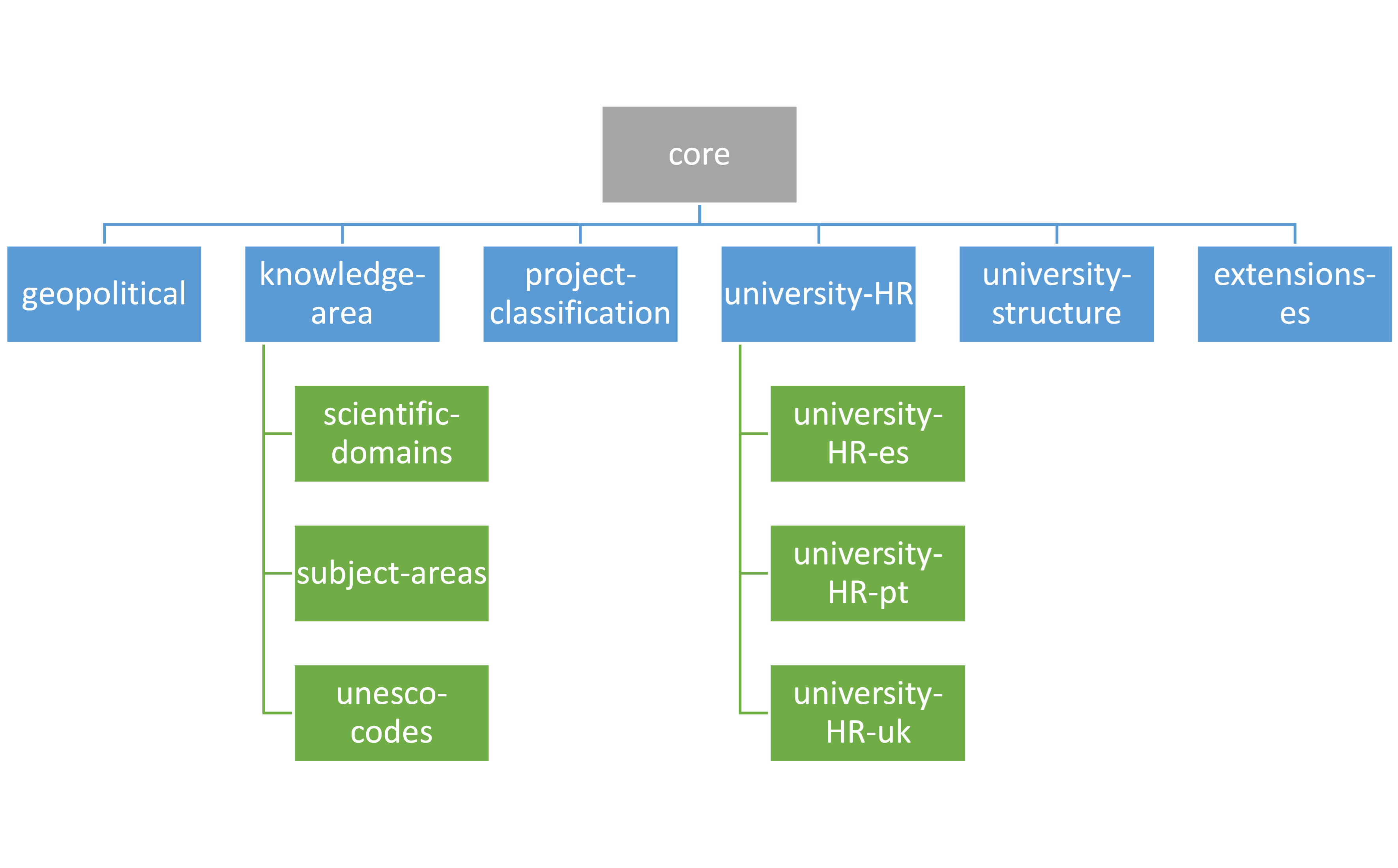 Figura 1. Hierarchical module structure of ROH network of ontologies.
Figura 1. Hierarchical module structure of ROH network of ontologies.
To incorporate specific modules to the ontology, it is enough to create a new ontology, import the required higher level ontology entities and create the new classes or properties needed. Both classes and properties can be integrated within the existing hierarchy in the imported ontology. Let’s say, for example, that a new university (e.g. University of Castilla La-Mancha) wants to make use of ROH and needs to add a series of positions of its own through which to classify research technicians. To do this, you can import the core ontology, and under vivo:Position, in which the hierarchies for the typical university positions appear, create your own as subclasses.
The automatically generated documentation, through the Widoco tool, for each ontological part is referenced below:
- Widoco generated documentation for ROH core module
- Widoco generated documentation for ROH vertical modules
The following table shows a summary of the reused ontologies together with their respective user licenses. All reused ontologies have been evaluated for compatibility with their import and extension.
| prefix | Ontology names | License | Ontology website |
|---|---|---|---|
| bibo | Bibliographic Ontology | Creative Commons Attribution 1.0 Generic (CC BY 1.0) | http://purl.org/ontology/bibo |
| foaf | FOAF (Friend of a Friend) Vocabulary Specification | Creative Commons Attribution License 1.0 | http://xmlns.com/foaf/0.1 |
| geonames | Geonames ontology | Creative Commons Attribution License 3.0 | http://www.geonames.org/ontology# |
| obo | Open Biological and Biomedical Ontology (OBO) | Creative Commons Attribution License 4.0 | http://purl.obolibrary.org/obo/ |
| obo-bfo | OBO Foundry, Basic Formal Ontology | Creative Commons Attribution License 4.0 | http://www.obofoundry.org/ontology/bfo.html |
| obo-ero | OBO Foundry, eagle-i Research Resource Ontology (ERO) | Creative Commons Attribution License 4.0 | https://open.catalyst.harvard.edu/wiki/display/eaglei/Ontology |
| obo-iao | OBO Foundry, Information Artifact Ontology | Creative Commons Attribution License 4.0 | https://github.com/information-artifact-ontology/IAO/ |
| obo-ro | OBO Foundry, Relations Ontology | Creative Commons Attribution License 4.0 | http://www.obofoundry.org/ontology/ro.html |
| rdfs | RDF Schema | Creative Commons Attribution License 4.0 | http://www.w3.org/2000/01/rdf-schema# |
| roh | Red de Ontologías Hercules | Creative Commons Attribution License 4.0 | http://w3id.org/roh |
| skos | SKOS Simple Knowledge Organization System RDF Schema | Creative Commons Attribution License 4.0 | http://www.w3.org/2004/02/skos/core# |
| terms | DCMI Metadata Terms | Creative Commons Attribution License 4.0 | https://www.dublincore.org/specifications/dublin-core/dcmi-terms/ |
| vcard | vCard Ontology - for describing People and Organizations | Creative Commons Attribution License 4.0 | https://www.w3.org/2006/vcard/ns# |
| vivo | VIVO Ontology for Researcher Discovery | Creative Commons Attribution License 4.0 | http://vivoweb.org/ontology/core# |
| oa | The Web Annotation Data Model | Creative Commons Attribution License 4.0 | http://www.w3.org/ns/oa# |
| cito | CiTO, the Citation Typing Ontology | Creative Commons Attribution 4.0 | http://purl.org/spar/cito# |
1.1. Design rationale
In order to maximize the reuse of ontologies established in the community and the compatibility of new developments within the framework of ASIO, priority has been given to the reuse of all those entities (both classes and properties) that already fulfilled the objective of modeling the different aspects required. These reused entities have been combined among them and with entities explicitly created in the ROH ontology in order to model the data properly.
When designing and developing the ontology, priority has been given to its flexibility to ensure easy extensibility. This has been achieved thanks to two factors: the categorization of concepts instead of the use of hierarchies and the modularity of the ontology. By avoiding hierarchies, the ontology can be much more flexible, since different institutions can use different hierarchies to classify their projects (for example, universities that classify their projects according to the geographical scope of the call, as opposed to other universities that classify them according to the public or private nature of the call). Against this, the use of categories has been prioritized, properties that allow the categorization of entities according to different criteria. However, thanks to its modular design (core and vertical modules), our ontology allows any European country, territorial administrative entity or university to develop its own sub-ontology (refinements and extensions) that adapts to its reality. This way, if an institution wants, for example, to create its own project hierarchy, it would only have to import the ontology of the immediately superior area and create its own hierarchy from the vivo:Project entity.
In the same way, and to avoid explicit declaration of hierarchies, a series of Defined Classes have been defined. A Defined Class is a class that cannot be an instance directly, but rather, an instance will belong to it only if it complies with a series of restrictions. These classes have been used to define, for example, when an organization is a Funding Organization. Instead of having to explicitly define the organization as a Funding Organization, the organization will be defined with its corresponding class (University, Research Organization, Government Agency, etc.) and in the event that it meets a series of restrictions, in this case, being a funder of some call, the OWL reasoner will automatically classify it as a Funding Organization.
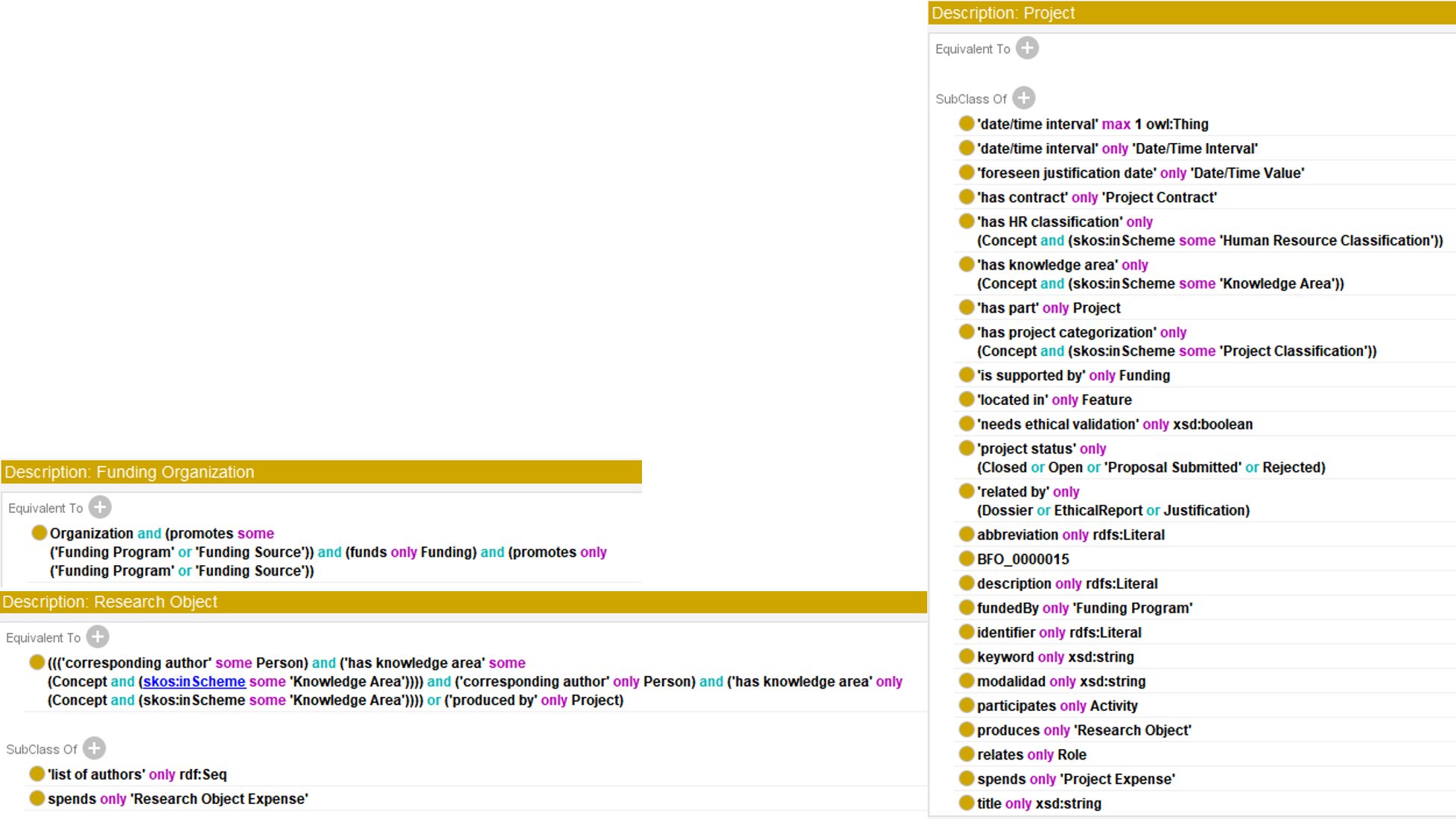
When implementing this ontology, the reuse of ontologies has been prioritized, thus allowing the compatibility of the data represented through ROH with other data represented through other ontologies.
Another feature has been the extensive use of OWL constraints (owl:allValuesFrom, and owl:someValuesFrom properties). Through these properties it is possible to indicate, for a specific class of the ontology, which properties are optional for an entity to belong to this class, as well as the corresponding range. This makes the ontology itself serve as documentation when modelling data.
In the process of creating this ontology network, the following design principles have been considered:
- Reusability - modelling of concepts again has been avoided if an ontology has been located that comprehensively models a given concept. E.g, the concept of a position held by a person in an academic organization, which is extensively documented in the ontology VIVO Ontology for Research Discovery.
- Extensibility - since, although academic information modelling shares many aspects universally, there are aspects that are specific to the country in question. E.g, 6-year periods in Spain, or the University or research centre in question, for example, job positions considered at the University of Murcia.
- Maintainability – the modularization of the network of ontologies in distinct contextualized refinements seeks an easier maintenability of ROH
- Integrity – by the application of ontological restrictions and validation scripts in languages like SHACL, to preserve also Integrity. The OWL
someandonlyrestrictions to express if a property is compulsory and the valid data type associated to it, respectively, have been used. Besides, the cardinality restrictionsmin,maxandexactlyhave been applied to the ontology. This allows to ensure a good validation of the instance data generated through ROH regarding the academic domain, since only the valid relationships in the correct cardinality can be established among entities. - Usability - in the design of ROH we did not only consider to make this network of ontologies comprehensive and exhaustive, i.e. covering the maximum number of academic world concepts and their properties, but also, and very importantly, making it USABLE.In ontological design, often entities and properties are very superficially described, following the Open World principle. However, we wanted, from the start, to make the devised network of ontologies usable by those that need to instantiate it, independently on whether they are ontology engineers or just developers. Developers working in a CRIS (current research information system) need to understand what properties are compulsory, which are optional, and what data types they need to use to populate RDF graphs through ROH. This explains why in ROH a big effort has been paid to document well the ontology and to introduce ontological restrictions that validate the correct instantiation of entities.
The most commonly used ontological design patterns in ROH design have been the following:
- PartOf: allows the representation of entities and their corresponding parts. For example, in ROH, a
foaf:Organizationobo-ro:hasPartfoaf:Organization, that is, an organization can be composed of sub-organizations, and this can beobo-ro:partOf, that is, be part of a parent organization. - Participation: allows you to represent the participation of an object in an activity or event. In ROH, we have used this design pattern to model, for example, the roles that a
foaf:Agentthrough anobo-bfo:Rolecan play (obo-bfo:realizedIn) in aroh:Activity.
1.2. Ontology design process
The process followed to design an ontology that models a Research Management System (RMS) for Spanish universities and that is piloted and validated at the University of Murcia, has been the following:
- Meet the requirements defined in “Annex I. Ontology requirements analysis” and “Annex II. Ontologies and other resources to be used”. Delivered by GNOSS-DEUSTO as part of the feasibility study for “R&D service for the development of the ontological infrastructure and semantic architecture of the research management system (sgi) of the Hercules initiative”, file number: 2018/88/OT-AM
- Selection and analysis of the main ontologies that model the academic environment. Including contrast with CERIF - ERD vocabulary, entity relationship diagram, since it is the standard information model for CRIS (Current Research Information System) systems.
- Identification of the main entities and relationships to model the knowledge of the academic world. Fulfilling the requirements of of the ASIO project.
- Validation of the flexibility, completeness and integrity of the ROH ontology network through the following evaluations:
- Review the questions/competency queries of the network listed by the University of Murcia (UM) and implement as a suite of SPARQL queries to validate their compliance. As a result of this validation, some new data and object properties were added.
- Review datasets offered by the University of Murcia and check that their data can be modelled with the entities and properties defined within ROH. Extension and adaptation of ROH entities according to the determined needs.
- Mapping of FECYT CVN format data to the ROH ontology. Where there were unmodelled entities or relationships, they were included. Details of the mapping between CVN and ROH entities appear in the cvn/config folder.
- Continuous refinement validated by a Continous Integration (CI) process. A battery of regression tests regulate that new changes introduced continue to guarantee the quality of ROH, its flexibility and extensibility to accommodate new requirements.
2. Conceptual diagram of ontology ROH
Figura 2 shows the main entities modelled in the Hercules Ontology Network (HON in English, ROH-Red de Ontologías Hércules in Spanish). Note that in the diagram, the arrows with a filled tip denote kinship (inheritance) relationships while the arrows that end in a non-filled tip indicate that there is an Object Property relationship between these entities. Finally, the dashed arrows reflect the fact that several entities in ROH have geographic (class Geonames:Feature) and temporal (class vivo:DateTimeInterval) constraints.
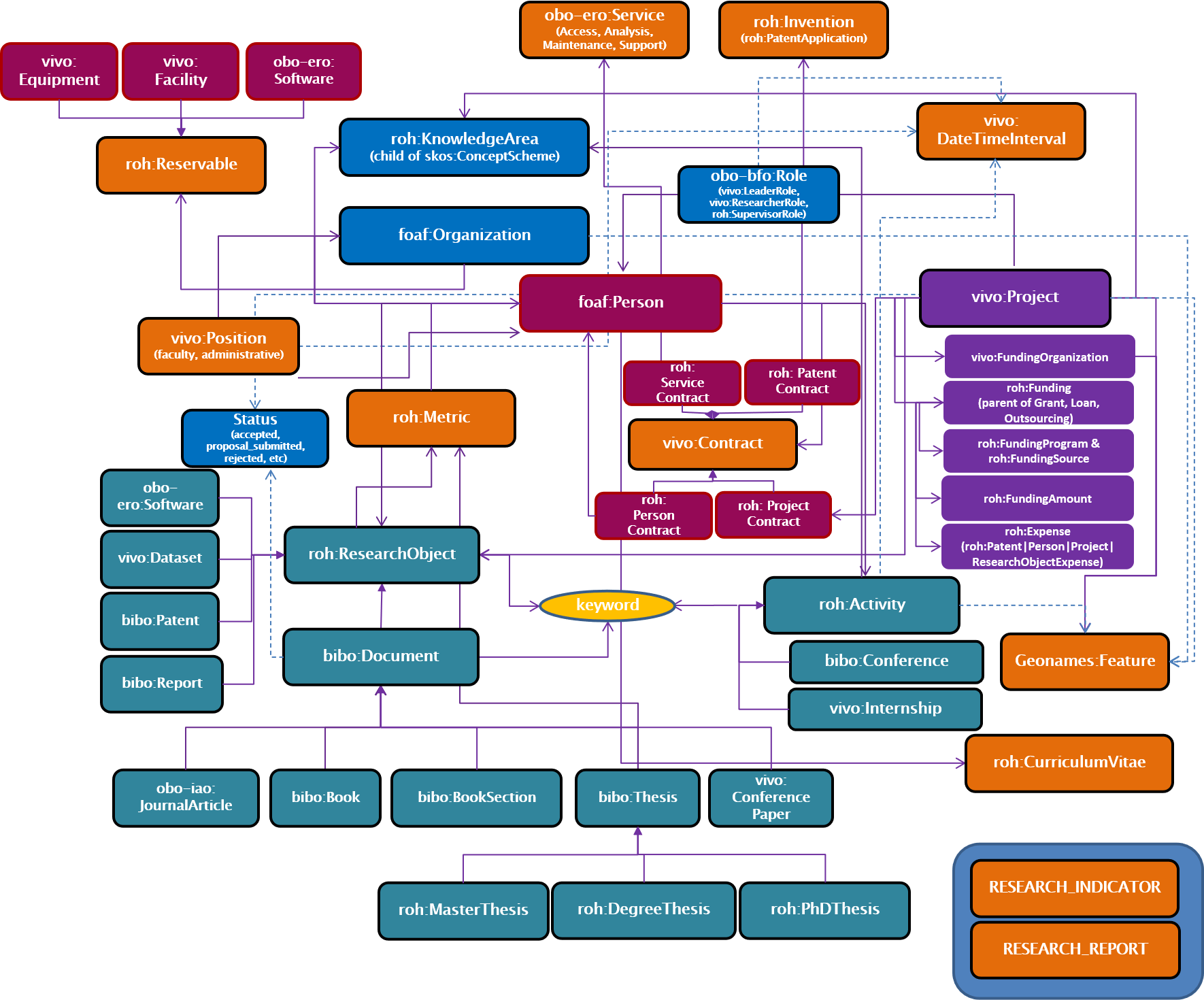
Figura 2. High level diagram of ROH –Red de Ontologías Hércules.
Notice that section 3 of the ROH Ontology Specification document includes a detailed discussion on how entities modelled in ROH have been imported and aligned with other existing entities in widely adopted ontologies that have successfully modelled parts of the Academic domain.
3. Project entity
The main ROH entity is vivo:Project (see Figura 3), a new entity defined within ROH. In ROH, a project models a collaborative activity in business and science that often involves research or design and is carefully planned to achieve a particular goal. Its configuration is inspired by the swrc:Project and takes into account the data properties of the cerif:Project and vivo:Project. It comprises all those properties and adds some new ones, for example, roh:projectStatus, roh:modality or roh:title.
It includes the Data Properties roh:identifier, vivo:abbreviation, vivo:description, roh:title, vivo:freeTextKeyword, roh:modality, roh:foreseenJustificationDate, roh:projectObjective and roh:needsEthicalValidation.
An vivo:Project includes a property roh:hasKnowledgeArea with allows to associate a project with different instances of knowledge areas, e.g. instances of skos:Concept belonging to roh:UNESCOKnowledgeArea controlled vocabulary or concept scheme. Besides, it allows a project to be classified (roh:hasProjectCategorization) according to the project categories defined in a hierarchy defined under the concept scheme roh:ProjectClassification, e.g. the concept instance http://w3id.org/roh/project-classification#Horizon2020. Likewise a project might be associated to the recruitment of a new human resource, in that case roh:hasHRClassification allows to link a project with a roh:HumenResourceClassification. A project may go through different stages, i.e. roh:projectStatus during its lifetime, e.g. roh:Open, roh:ProposalSubmitted, roh:Rejected or roh:Closed.
Besides, an instance of a vivo:Project is associated to the following entities through object properties:
- An
roh:Activityisroh:participatedByby a project, describes what activities a project participates in. skos:Conceptis linked throughroh:knowledgeAreaOfto a project, indicating the topics/concepts a project deals with. A project may be classified according to distinct taxonomies (concept schemes) for roh:ProjectClassificationandroh:HRClassification(human resources).roh:Dossierthrough relationshipvivo:relatesbinds a set of documents, including the proposal, evaluation document, reports and so on with avivo:Project. A dossier is an administrative file collection in which all assets related to a project are stored, including the research pProposal, approval documents, viability plans and so on associated to a project are stored.roh:Fundingthroughroh:supportsavivo:Project, where a funding is divided into (throughobo-ro:BFO_0000051 (has part)) several Funding Amounts (roh:FundingAmount). Aroh:FundingAmountroh:grantsafoaf:Organizationand describes the details about the funding associated to a project to given organization, indcluding period and amounts. Aroh:FundingSourceisroh:promotedByavivo:FundingProgramwhich isroh:promotedByavivo:FundingOrganization. Different organizations (foaf:Organization) may play different (obo-bfo:BFO_0000023) roles in a project, e.g.vivo:MemberRoleorvivo:AdministratorRole. Notice that the object propertyvivo:relatesallows to link afoaf:Agent, being it either an Organization or a Person, with a (obo-bfo:BFO_0000023) role.roh:Justificationthrough relationshipvivo:relatesbinds justifications with avivo:Project.foaf:Person, where a person may play different (obo-bfo:BFO_0000023) roles, e.g.vivo:PrincipalInvestigatorRoleorvivo:ResearcherRole.vivo:ProjectContractsubtype ofvivo:Contractallows a project to be associated to a contract through relationshiproh:hasContract.roh:ProjectExpenseisroh:spentBya project, details allows to associate a project with its expenses.roh:ResearchObject, where a projectroh:producesseveralroh:ResearchObject, where some results of a project might be for example of typesbibo:Journal,obo-iao:JournalArticle, orroh:PhDThesis.
Notice that a vivo:Project may also be part (obo-ro:BFO_0000051) of another project, e.g. child of a parent project. Besides, every instance of a vivo:Project is time bound by being associated with an instance of vivo:DateTimeInterval and geographically bound to an instance of gn:Feature (through relationship (gn:locatedIn).
The following table shows the object and data properties associated to vivo:Project:


Figura 3. Ontological diagram for entity Project.
4. Person entity
In ROH, there is a foaf:Person entity (see Figura 4) that inherits from foaf:Agent. The specialization of this entity imported from the VIVO ontology already adds some DataType properties of the research domain, but in ROH we have also incorporated roh:taxID, roh:ORCID, vivo:researcherId or vivo:scopusId (all of them are subtypes of vivo:identifier, a given person may use or several alternatives of those identifiers) and also several object specific properties of the research domain as "has a Role" (roh:hasRole) in an Organization, "has a CurriculumVitae" (roh:hasCV), "has some Accreditations" (roh:hasAccreditation), "has an Employment Contract" (roh:hasContract), "has some Knowledge Areas" (roh:hasKnowledgeArea) or "has some Roles" (roh:hasRole) in Projects or participates through bibo:authorList with Research Objects of subclass bibo:Document. A person can "have different roles" in the Project over time. As a subclass of foaf:Agent inherits some additional object properties such as roh:hasAccreditation or roh:hasContactInfo.
As mentioned above, foaf:Person in ROH is based on FOAF (Friend of a Friend [2], following patterns used in VIVO. That explains why it includes some of the basic FOAF properties such as foaf:name, foaf:nickname, foaf:title, foaf:mbox (note that this in fact an object property), foaf:img (note that this in fact an object property), vivo:description, foaf:firstName and foaf:surname. However, it considers all attributes and links defined in CERIF through the cfPers entity. foaf:Person incorporates the following data properties declared as attributes in cfPers, especially: identifier (vivo:identifier but preferably roh:ORCID), roh:birthdate, foaf:gender, foaf:homepage (note that this in fact an object property), roh:researchLine, vivo:freeTextKeyword. Some important CERIF relationships that have also been adopted: Curriculum Vitae (roh:hasCV) which links foaf:Person with roh:CurriculumVitae, Event (roh:Activity) and Indicator (roh:Accreditation).
Besides, an instance of a foaf:Person is associated to the following entities through object properties:
roh:AuthorMetric, where a researcher may have associated metric values such as h-index or i10 index.roh:AcademicSubject, where a researcher may teach different subjects, which is a concept scheme.vivo:AwardedDegree, where a researchervivo:relateswith anroh:AcademicDegreeroh:Accreditation, where a researcherroh:hasAccreditationof different types, e.g.roh:ResearchAccreditationorroh:AcademicAccreditation.roh:Activity, where a researcherroh:participatesin diverse activities, e.g.vivo:InvitedTalkorbibo:Conference.skos:Conceptis linked throughroh:knowledgeAreaOfto a person, indicating the different knowledge areas (roh:KnowledgeArea) a researcher is specialized on.roh:CurriculumVitae, where a researcherroh:hasCVwhich includes a data type property likeroh:summary. A researcher is also bound to author metricsroh:AuthorMetricthrough propertyroh:hasMetric.bibo:Document,roh:ExperimentalProtocol, andobo-ero:ERO_0000071(Software), where a researcher throughroh:seqOfAuthorsis participating in abibo:Document,roh:ExperimentalProtocolorobo-ero:ERO_0000071(Software) as one of its authors. In the case ofbibo:Documentthe object propertybibo:AuthorListalso can be used.vcard:Individual, where a researcherroh:hasContactInfodescribed through ontology vcard.vivo:Position, where a researcherroh:hasPositionusually in an organization linking it to any of thevivo:Positionsubclasess likevivo:FacultyAdministrativePositionorvivo:FacultyPosition.vivo:PersonExpense, where a researcher may contribute with several expenses for its research activities.roh:ResearchObject, where a researcher is theroh:correspondingAuthorof different subtypes ofroh:ResearchObject, e.g.obo-iao:JournalArticle,vivo:ConferencePaperorbibo:Proceedings.obo-bfo:BFO_0000023(Role), where afoaf:Agentmayroh:hasRolelikevivo:ResearcherRoleorvivo:TeacherRoleeither in avivo:Projector afoaf:Organization.roh:PersonContract, where a researcherroh:hasContractdescribed according to the attributes corresponding to parent classvivo:Contract.bibo:Thesis, where a researcher isroh:supervisorOfof abibo:Thesis, concretely, any of its subtypes subclasess likeroh:MasterThesisorroh:PhDThesis.
The following table fully describes the object and data properties defined within the foaf:Person entity in ROH.
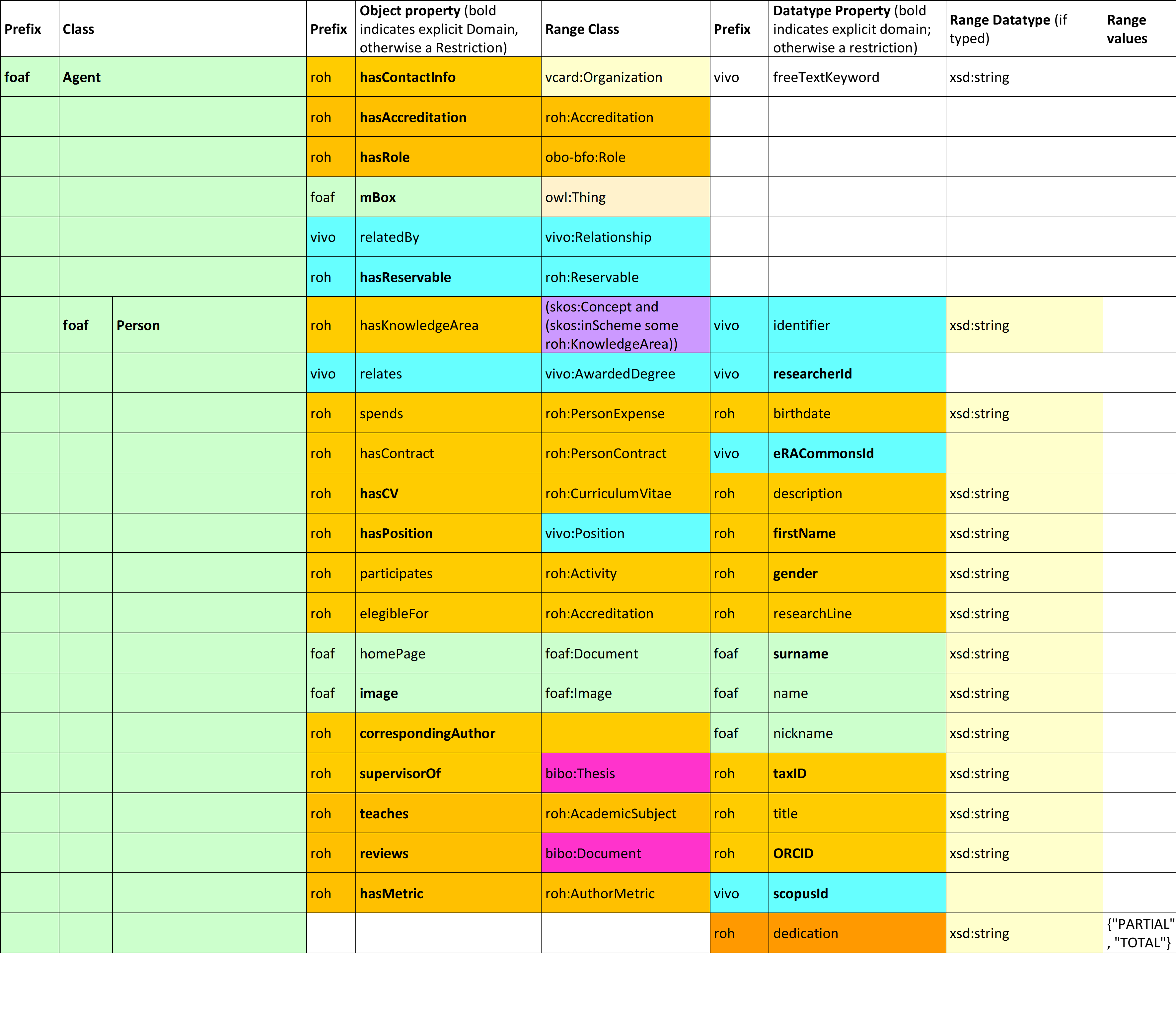
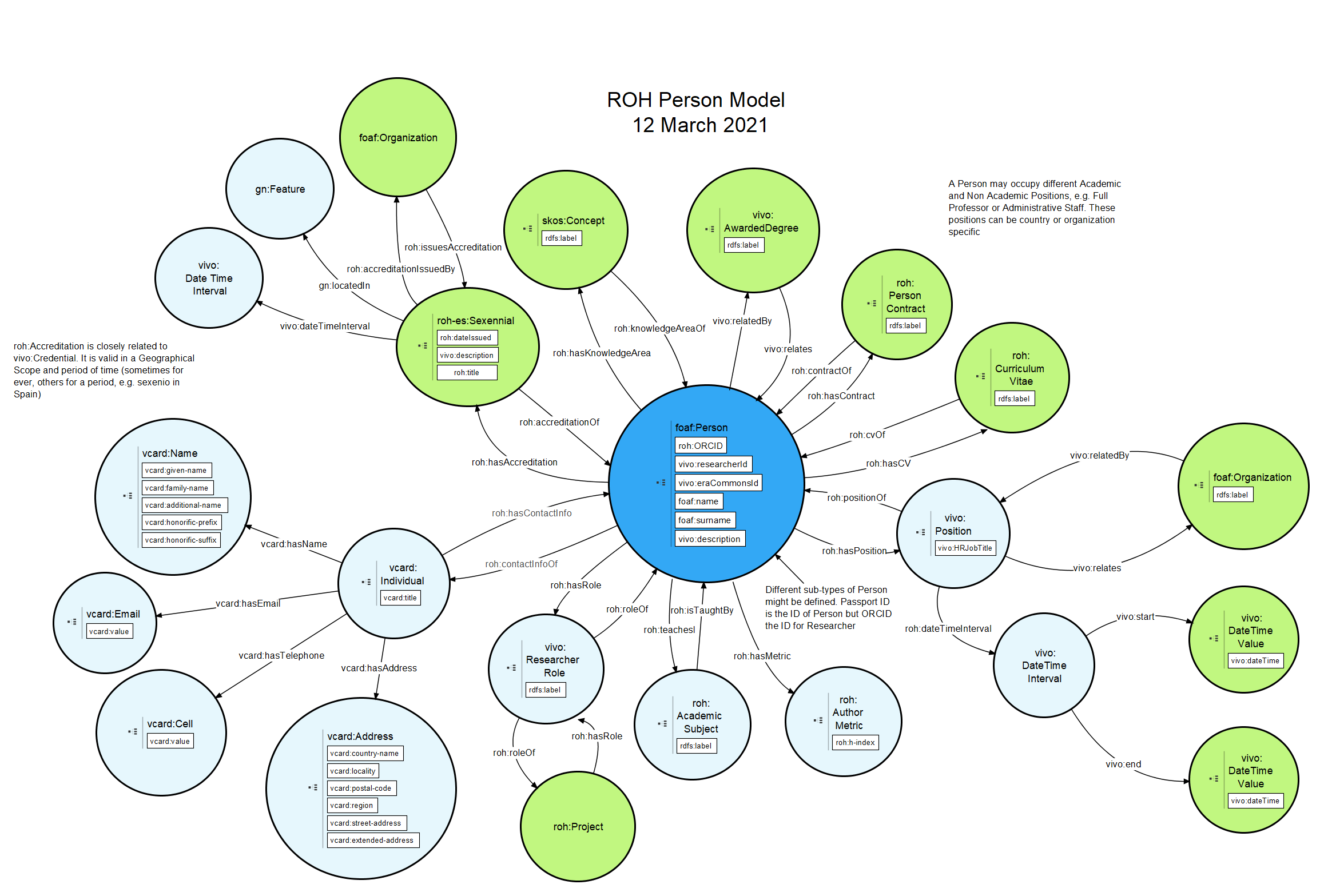
Figura 4. Ontological Diagram for entity Person.
5. Organization entity
An Organization in ROH (see Figura 5) is a foaf:Organization which carries out several vivo:Projects. It is a child of foaf:Agent. Some organization can emit roh:Acreditation (e.g. ANECA or CENAI in Spain), those belonging to subclass roh:AccreditationIssuer, or award degrees (vivo:AwardedDegree), those of subclass vivo:University. An Organization may receive several roh:FundingAmounts, corresponding to a roh:Funding, obtained through a roh:FundingProgram provided by a vivo:FundingOrganization through a roh:FundingSource. As a foaf:Agent an Organization may be involved in several roh:Actititys, has several instances of attribute vivo:freetextKeyword, is associated through roh:hasKnowledgeArea with roh:KnowledgeArea and bound to a geographical scope through gn:locatedIn with gn:Feature, it may also have a time span through vivo:dateTimeInterval linking it with an instance of vivo:DateTimeInterval.
Based on FOAF [10], the foaf:Organization entity takes into account the data properties (attributes: vivo:abbreviation, foaf:homepage) and data properties (links) defined by the Organization Unit in CERIF. It also takes into account and supports the relationships of CERIF Equipment (via entity vivo:Equipment and object property roh:hasReservable), Event (roh:Activity), Expertise and Skill (via vivo:freeTextKeyword and roh:hasKnowledgeArea), Facility (roh:Facility and roh:hasReservable), Funding (roh:Funding), Organization Unit (kinship relationships between organizations can be established with obo-ro:BFO_0000051 (has part) and obo-ro:BFO_0000051 (part of), Prize Award (through roh:Accreditation), Result Patent, Result Product, Result Publication and Service - all of them through roh:ResearchObject which can be obtained through the roh:produces relationship from the Projects in which an organization participates by playing a declared role through roh:hasRole, Person (through roh:hasPosition) may hold different positions. Therefore, the CERIF data model for Organization is covered.
An exhaustive hierarchy of organizations is included, e.g. roh:AccreditationIssuer, vivo:Company or vivo:University, among many others.
Besides, an instance of a foaf:Organization is associated to the following entities through object properties:
roh:Accreditation, where an organization of typeroh:AccrediationIssuerissues (roh:issues) accreditations, e.g.roh:ResearchAccreditationorroh:AcademicAccreditation.roh:Activity, where an organization may playvivo:OrganizerRolethroughroh:hasRolein an activity or may through its participation role in a project participate (roh:participates) in an activity.vivo:AwardedDegree, where avivo:Universitymayroh:awardsdegrees which are related to both a concretevivo:AcademicDegreeand an instance offoaf:Person.skos:Concept, where an organization throughroh:hasKnowledgeAreamay be associated to several knowledge areas, defined as instance data of thesaurus created with SKOS ontology. A concept linked to an organization must necessary belong toroh:KnowledgeAreaconcept scheme.vivo:Company, where an organization might be linked to several spinoffs through object propertyroh:hasSpinOff.vivo:DateTimeInterval, where an organization may exist during a given time intervalfoaf:Document, where an organization may be associated to several homepagesfoaf:homePagegn:Featurethrough relationshipgn:locatedIn, where an organization may be associated a geographical scope.roh:FundingAmountwhere an organization may receive several funding amounts part of aroh:Fundingthroughroh:grantsobject property.vcard:Organization, where an organizationroh:hasContactInfodescribed through ontology vcard.roh:Reservable, where an organization mayroh:hasReservable, belonging to any of its subclasses, e.g.roh:Equipment,roh:Facilityorobo-ero:ERO_0000071(Software).roh:PatentApplicationorbibo:Patentwhere an organization is the owner(roh:ownerOrganizationOf) of different patent applications or granted patents. Notice that aroh:PatentApplicationgoes through different status (roh:patentStatus) and is associated with a granted patent (bibo:Patent), only when its status passes to beroh:Accepted, through object property (roh:hasPatent).foaf:Organization, where an organization may be linked throughvivo:hasSucessorOrganizationorvivo:hasPredecessorOrganizationwith anotherfoaf:Organizationor may be part of (obo-ro:BFO_0000050) or includeobo-ro:BFO_0000051(has part) other severalfoaf:Organizations.obo-ero:ERO_0000005(Service), where an organizationroh:providesseveral services, e.g.obo-ero:ERO_0000392(Storage Service).roh:ResearchObject, where afoaf:Organizationmay be linked throughroh:correspondingOrganizationwith someroh:ResearchObject.
Check the following table for more details on object and data properties for foaf:Organization.

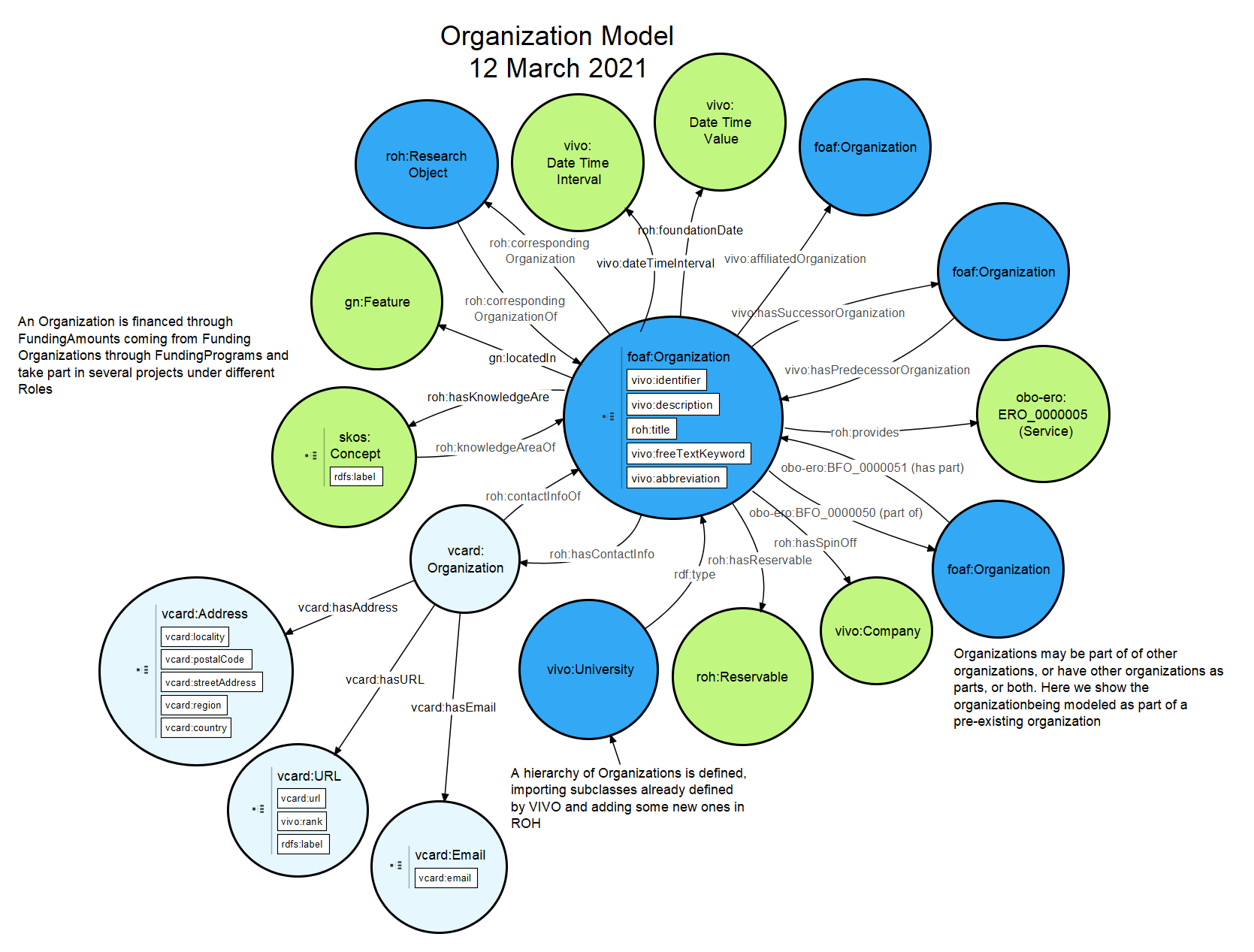
Figura 5. Ontological diagram for entity Organization.
6. Funding entity
The roh:Funding entity (see Figura 6), new in ROH, represents the funding associated with a project (vivo:Project) whose funding is associated with a funding program (roh:FundingProgram) and comes from a (roh:FundingSource), which in turn is associated with a funding organization (vivo:FundingOrganization). A funding is divided into several amounts (roh:FundingAmount), associated with the different entities that participate in a project and the annuities in which they do so. Funding amounts for an organization in a projects are expressed through data properties roh:monetaryAmount and roh:currency.
A funding can be marked as public through property roh:publicFunding, qualified by properties vivo:identifier, vivo:description and vivo:freeTextKeyword and classified into any of the following subclasses: roh:Grant, roh:Loan, roh:Outsourcing or roh:RefundableAdvance.
The funding organization (vivo:FundingOrganization) (see Figura 6), imported from VIVO [1], inherits from foaf:Organization, promotes (roh:promotes) research through different funding programs (roh:FundingProgram) and through different funding sources (roh:FundingSource). A roh:Funding is associated with roh:FundingAmounts through object property obo-ro:BFO_0000051 (has part). A roh:FundingProgram funds (roh:funds) a roh:Funding, funding programs are promoted by roh:FundingOrganizations. Notice that a roh:Funding is divided into several roh:FundingAmounts associated with different foaf:Organizations through the roh:grants relationship.
The Funding Program entity (roh:FundingProgram) (see Figura 6), new in ROH, defines the funding initiatives promoted (roh:promotedBy) by a Funding Organization (roh:FundingOrganization) which is, likewise, promoted by a roh:FundingSource. A funding is in operation during a time interval (vivo:dateTimeInterval) and is usually linked to a geographical scope (geonames:Feature) as determined by the roh:FundingProgram.
The following table illustrates the object and data properties associated to entities dealing with the funding concept in ROH.
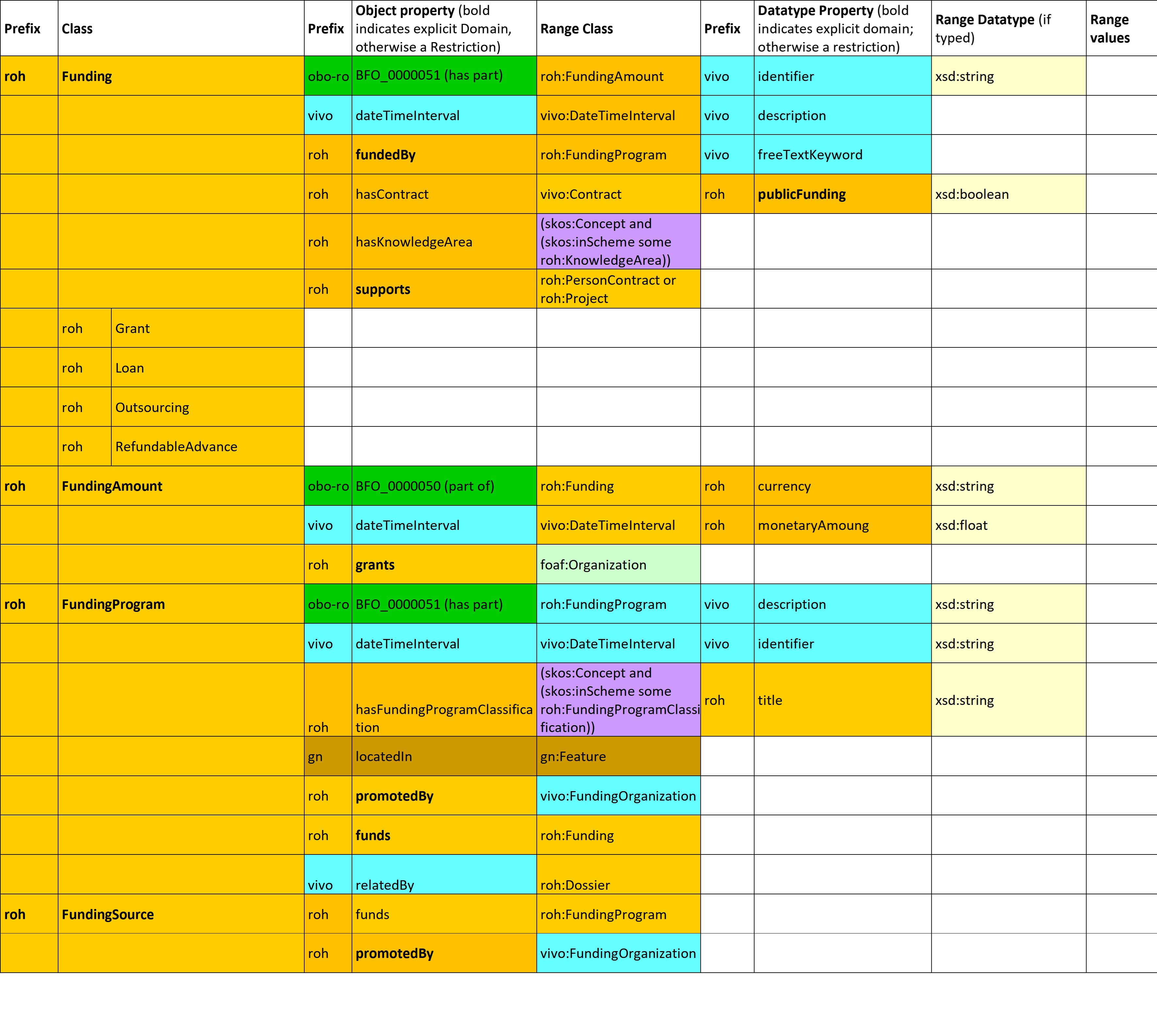
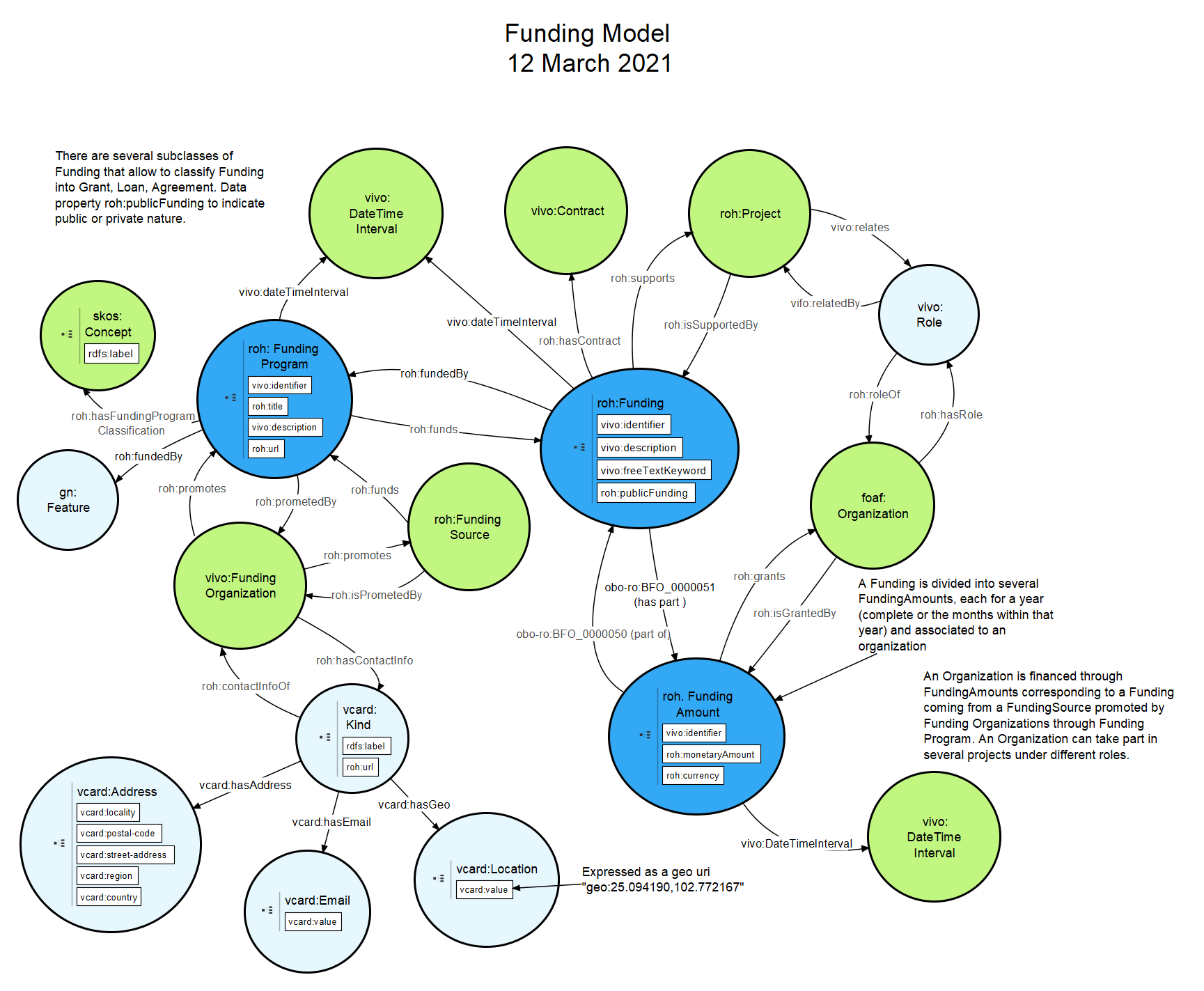
Figura 6. Ontological diagram for Funding.
7. Research Result and Research Object Entities
The research object entity (roh:ResearchObject) is a new entity defined in ROH that corresponds to a research result (roh:ResearchResult) generated by a person (researcher), usually through work on a project. Notice that roh:ResearchObject is a subclass of roh:ResearchResult and a defined class, which follows these restrictions: ('part of research result' some 'Research Result') or ('produced by' only vivo:Project). This is, an instance in ROH belongs to class roh:ResearchObject if it meets these restrictions. Usually a roh:ResearchObject results from working on a vivo:Project (roh:produces), which is modelled with the second constraint ('produced by' only vivo:Project). Regarding the first restriction, an instance of ero:software, bibo:Document and roh:ExperimentalProtocol is a research object only if this instance is part of (roh:partOfResearchResult) some roh:ResearchResult declared by some researcher. Thus, each roh:ResearchResult and the roh:ResearchObjects that compose it are specific to the author who creates the research result and declares its elements. So, if an article is created by two researchers, one of them can declare it as a research object making this article part of his research result, while the other researcher can not declare it if he does not want to.
A research object has been modelled, around entities obo-iao: IAO_0000030 (Information Content Entity), roh:ExperimentalProtocol, and obo-ero:ERO_0000071. Such entities are linked to at least one foaf:Person through object property roh:correspondingAuthor. The contributors of a research object are accessible through object property roh:seqOfAuthors, or in the case of bibo:Document (subclass of obo-iao: IAO_0000030 (Information Content Entity)) the contributors are also accessible through object property bibo:authorList. The primary author of a research object is accessible through the roh:correspondingAuthor property and the responsible organization of a research object is accessible through roh:correspondingOrganization. A roh:ResearchObject may have several knowledge areas bound to it through roh:hasKnowledgeArea, where the linked concepts should be associated to concept scheme roh:KnowledgeArea or one of its subclasses. The vertical module knowledge-area contains relevant instance data scientific domains, research subjects and UNESCO codes.
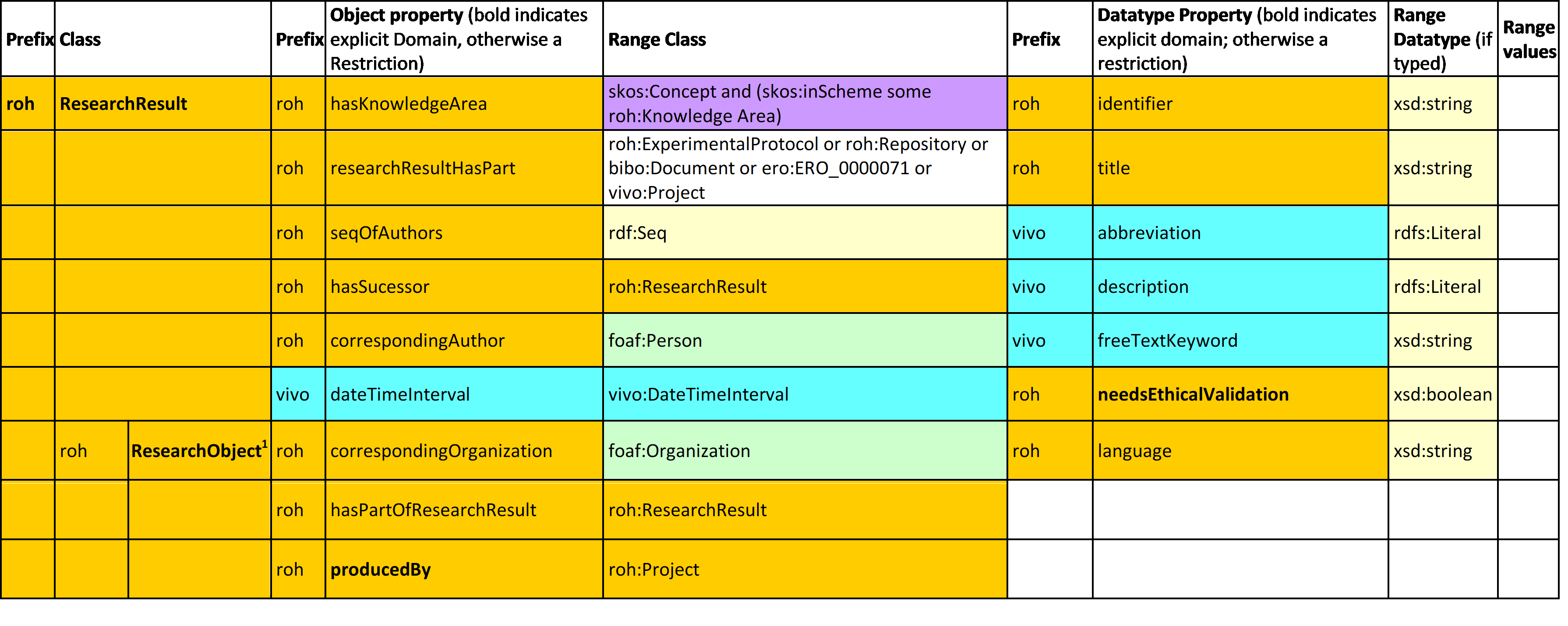
7.1 obo-iao: IAO_0000030 (Information Content Entity) Entity)
Under obo-iao: IAO_0000030 (Information Content Entity) entity a complete taxonomy of entities mostly imported from BIBO [4], covering all kinds of publications, patents, and web pages, is defined. Some examples are: bibo:Collection, bibo:Journal, bibo:Article, bibo:Book, bibo:Chapter, vivo:DataSet, bibo:Patent, bibo:Thesis and bibo:Webpage.
The concept publication it’s the most important and is defined mainly through the imported entity bibo:Document. Currently, the following sets of entities related to the publication concept are supported: bibo:Collection (Newspaper, Magazine) and bibo:Document (Article, ConferencePaper, EditorialArticle, Book, Proceedings, ConferencePaper, Chapter, Thesis). bibo:Thesis has been refined into roh:BachelorsThesis, roh:MastersThesis and roh:PhDThesis.
Two entities worth mentioning that belong to the hierarchy of classes associated to the vivo:Project are: bibo:Report and roh:Dossier. A bibo:Report has been refined to include subclasses roh:EthicalReport (which includes roh:EthicalAudit and roh:EthicalValidation), roh:EvaluationSummary, roh:Justification and roh:ResearchProposal. This implies that a report may correspond to ethical validation and auditing needs of a project, correspond to the evaluation of the project, its proposal or the set of documents corresponding to its justification. On the other that represents a collection of reports related to a vivo:Project, which may include all the types of reports above mentioned.
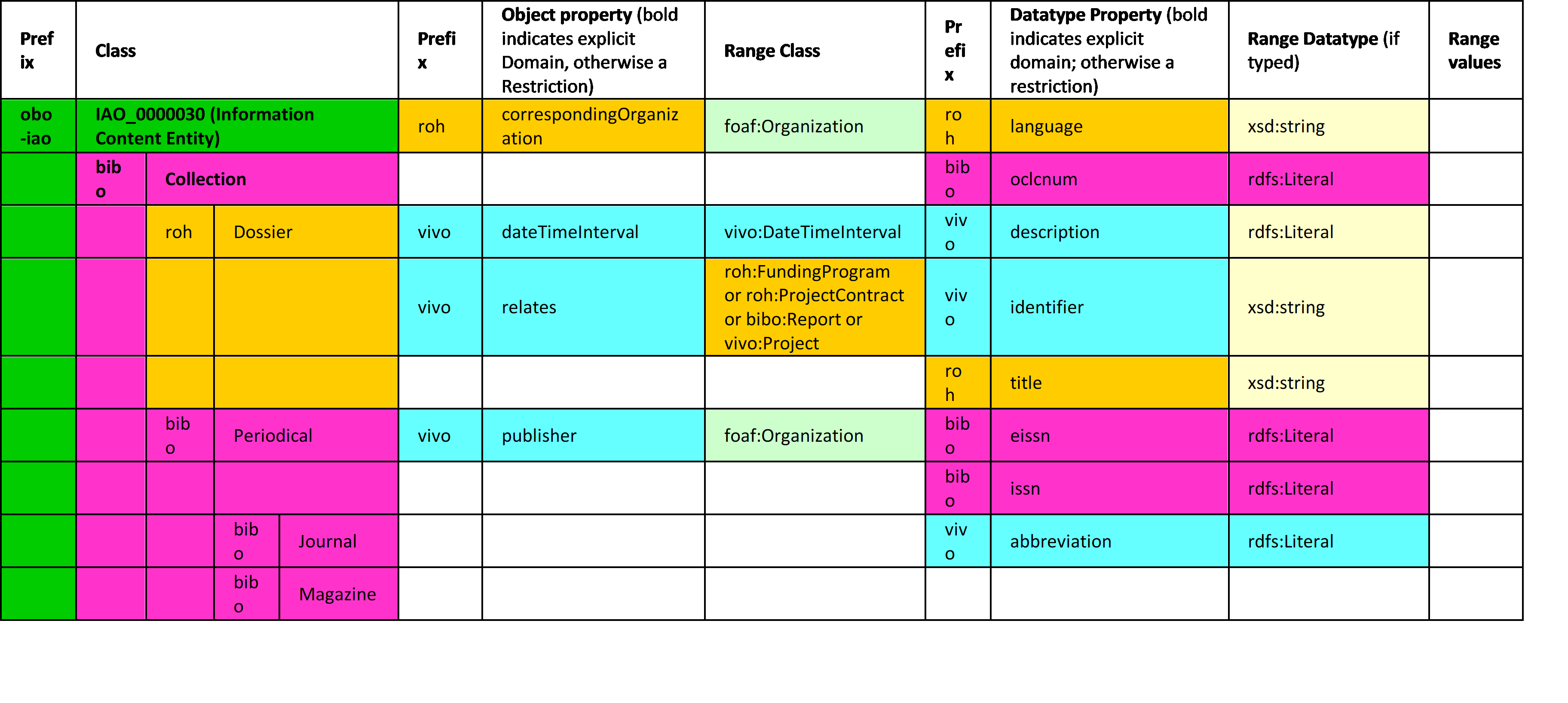
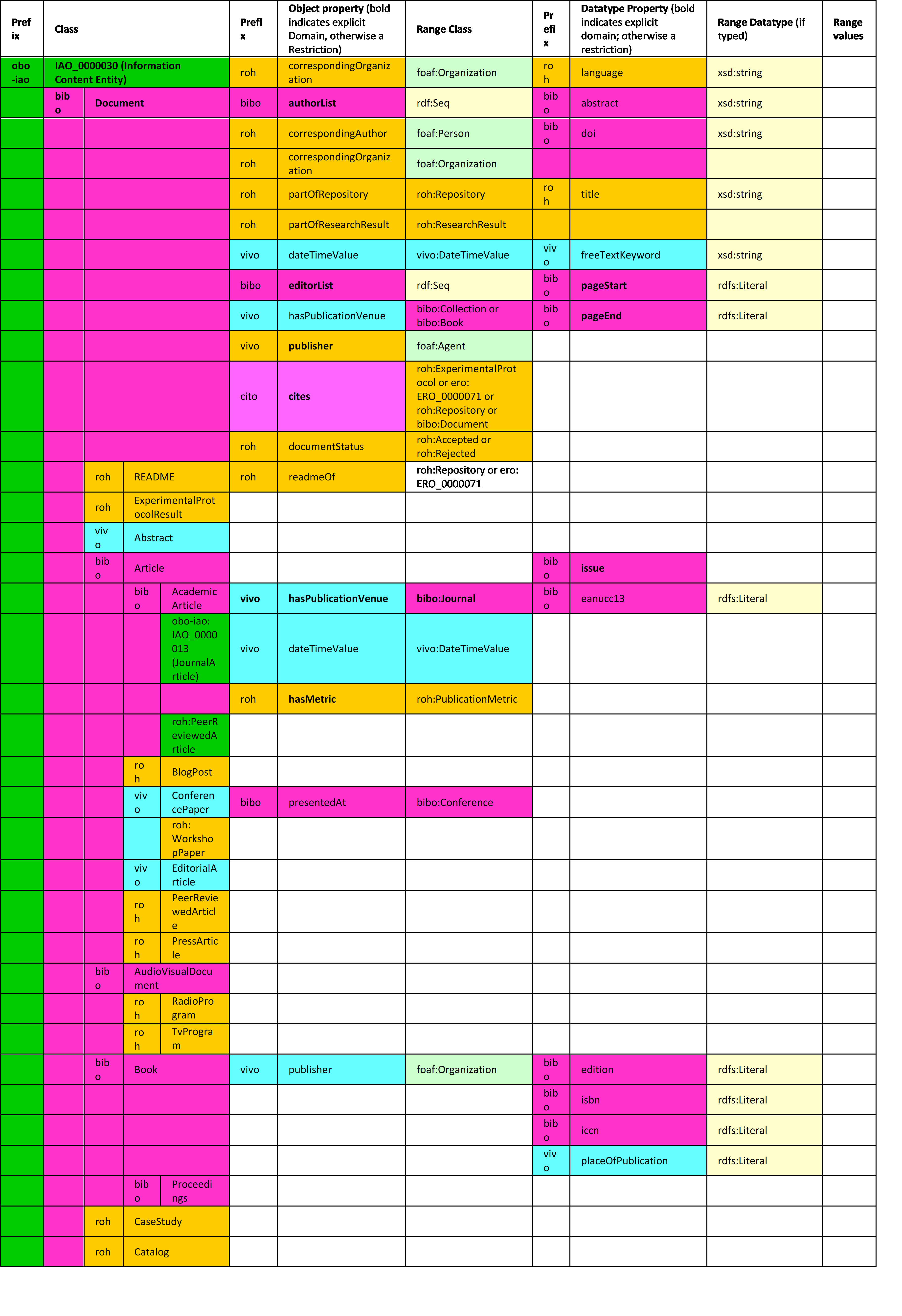
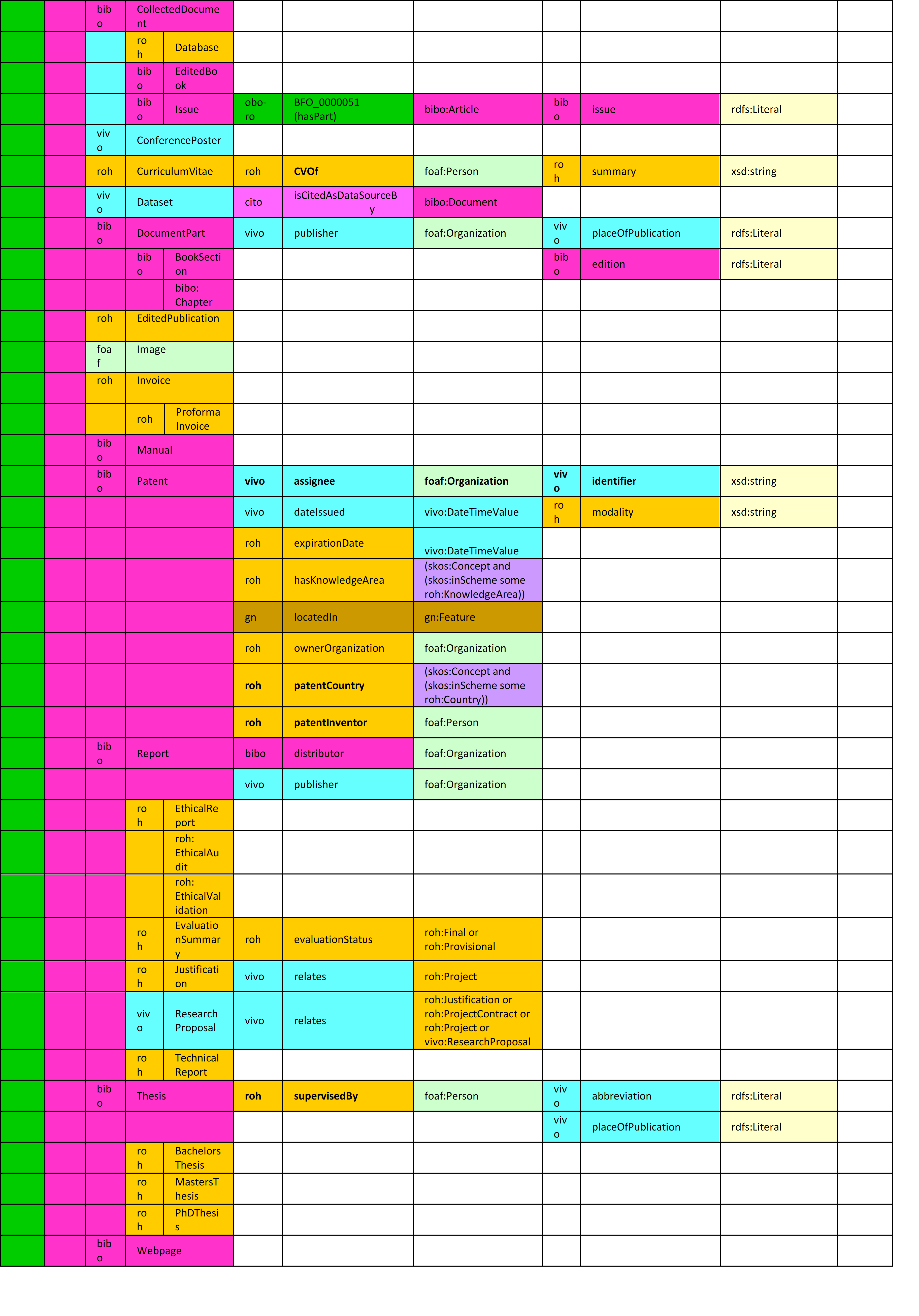

Figura 7. Ontological diagram for AcademicArticle.
Another important sub-entity of obo-iao: IAO_0000030 (Information Content Entity) is roh:Repository (see Figure 8). Documents, pieces of software, experimental protocols or data can be linked to repository (roh:Repository) that contains them through the object property roh:partOfRepository. roh:Repository is associated through roh:hasSucessor with another roh:Repository when it is a predecessor or fork of the first one, and through roh:hasReadme with the document describing the structure of the repository roh:README. This entity can be linked with the contributors through roh:seqOfAuthors, to the primary author (foaf:Person) through roh:correspondingAuthor, to corresponding organization (foaf:Organization) through roh:correspondingOrganization.
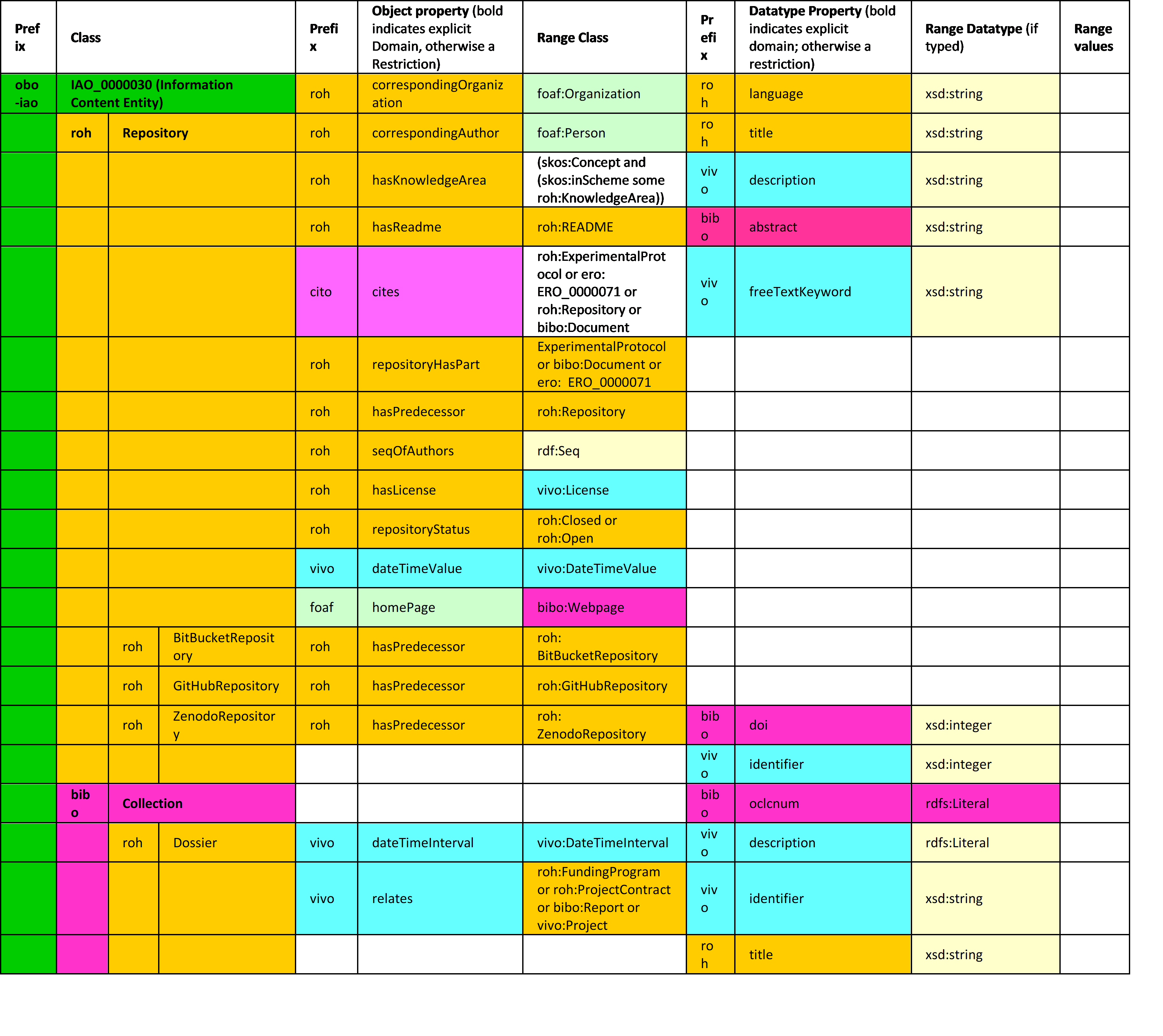
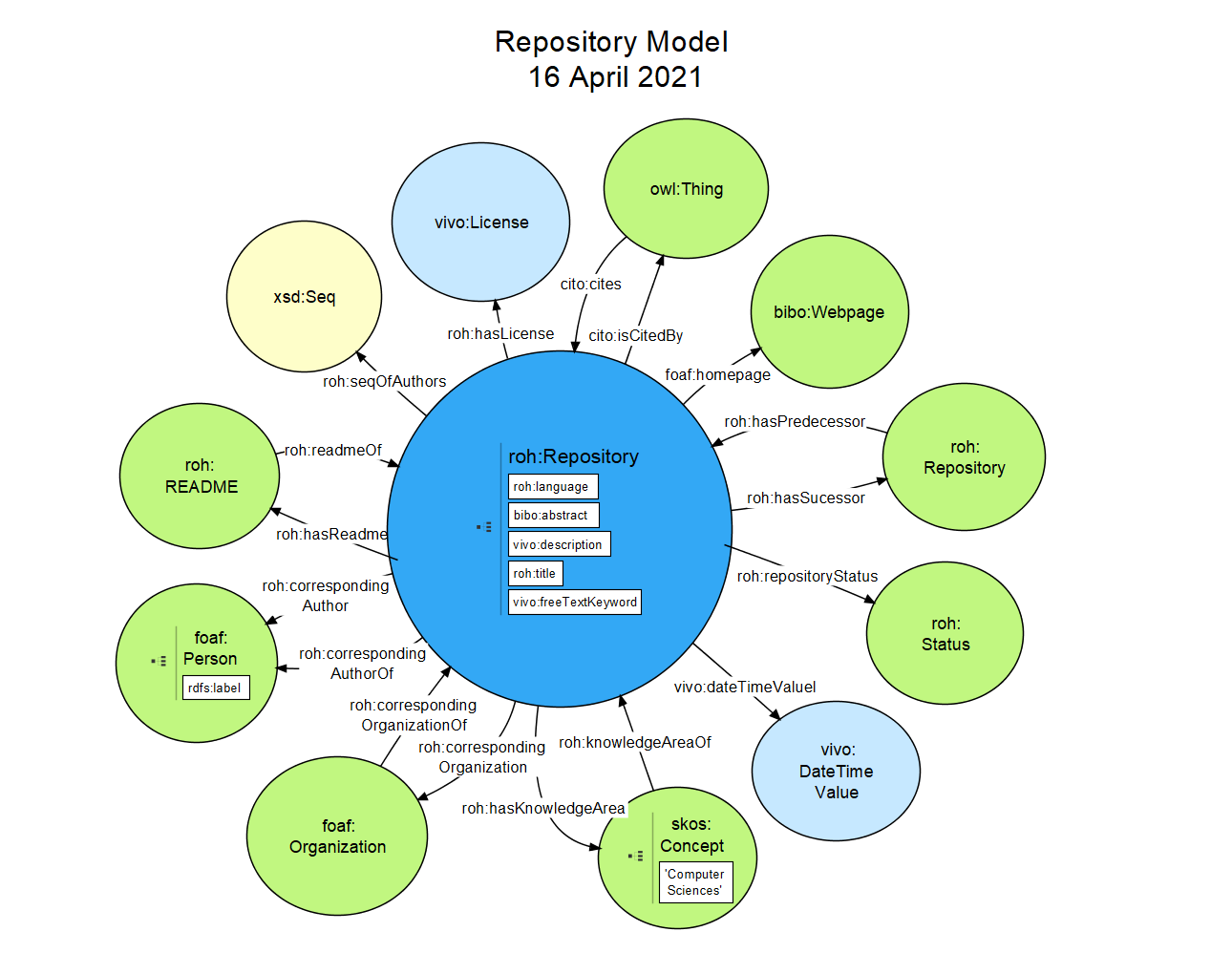
Figura 8. Ontological diagram for Repository.
7.2 roh:ExperimentalProtocol Entity
The roh:ExperimentalProtocol entity (see Figure 9), new in ROH, models the process or protocol to perform an experiment. The roh:ExperimentalProtocol entity may be linked to the roh:ExperimentalProtocolResult entity, a document that exposes the result of carrying out this process with some concrete data, through roh:produces.
The following table illustrates the object and data properties associated to entity roh:ExperimentalProtocol.
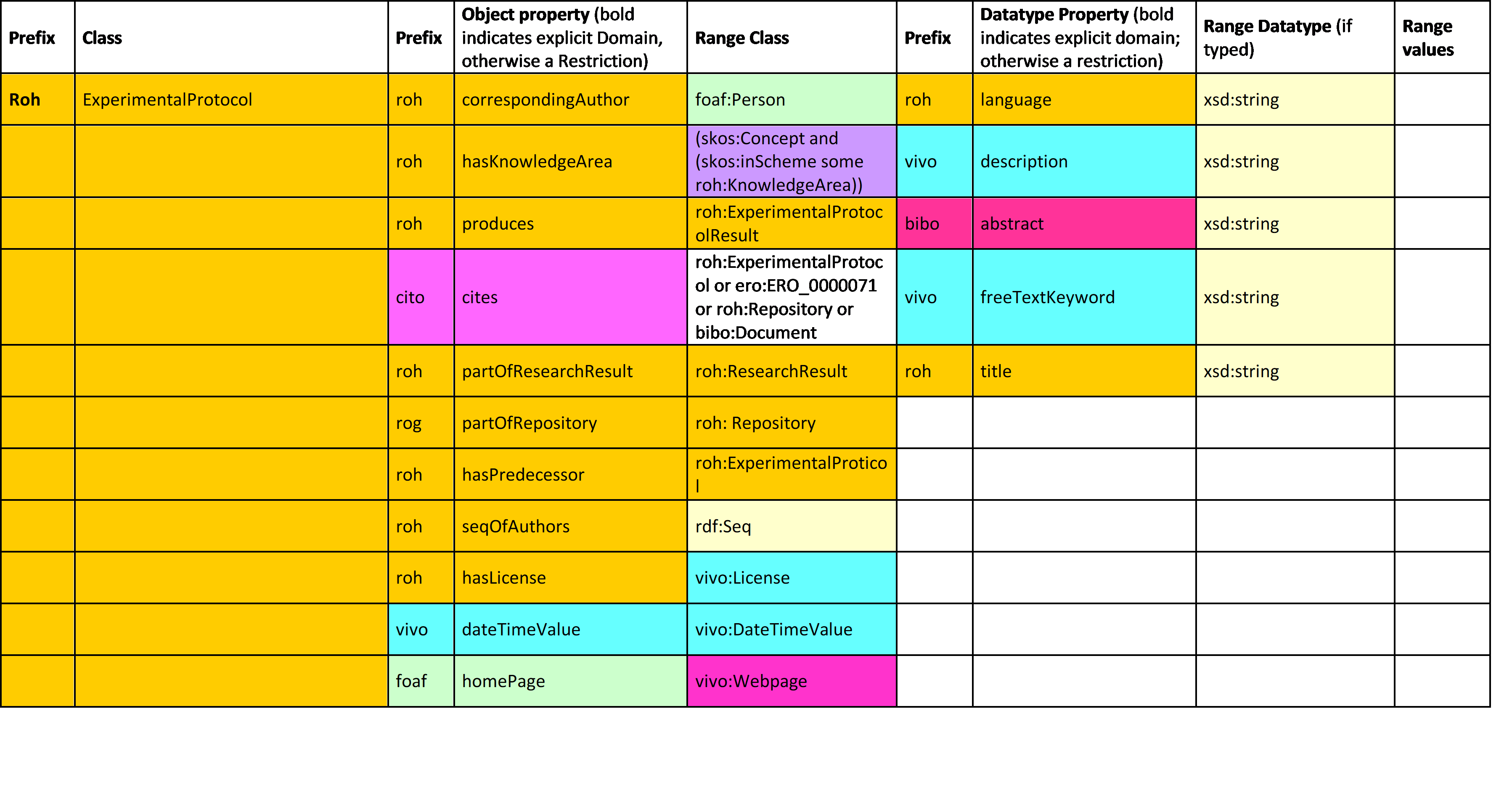

Figura 9. Ontological diagram for Experimental Protocol.
7.3 obo-ero:ERO_0000071 (Software) Entity
The software entity is imported from the obo-ero ontology. Software is associated through roh:hasSucessor with another roh:software when the latter is based on the first one, and through roh:hasReadme with the document describing the software roh:README. The programming language for a software is expressed through data property roh:programmingLanguage.
The following table illustrates the object and data properties associated to obo-ero:ERO_0000071 (Software).
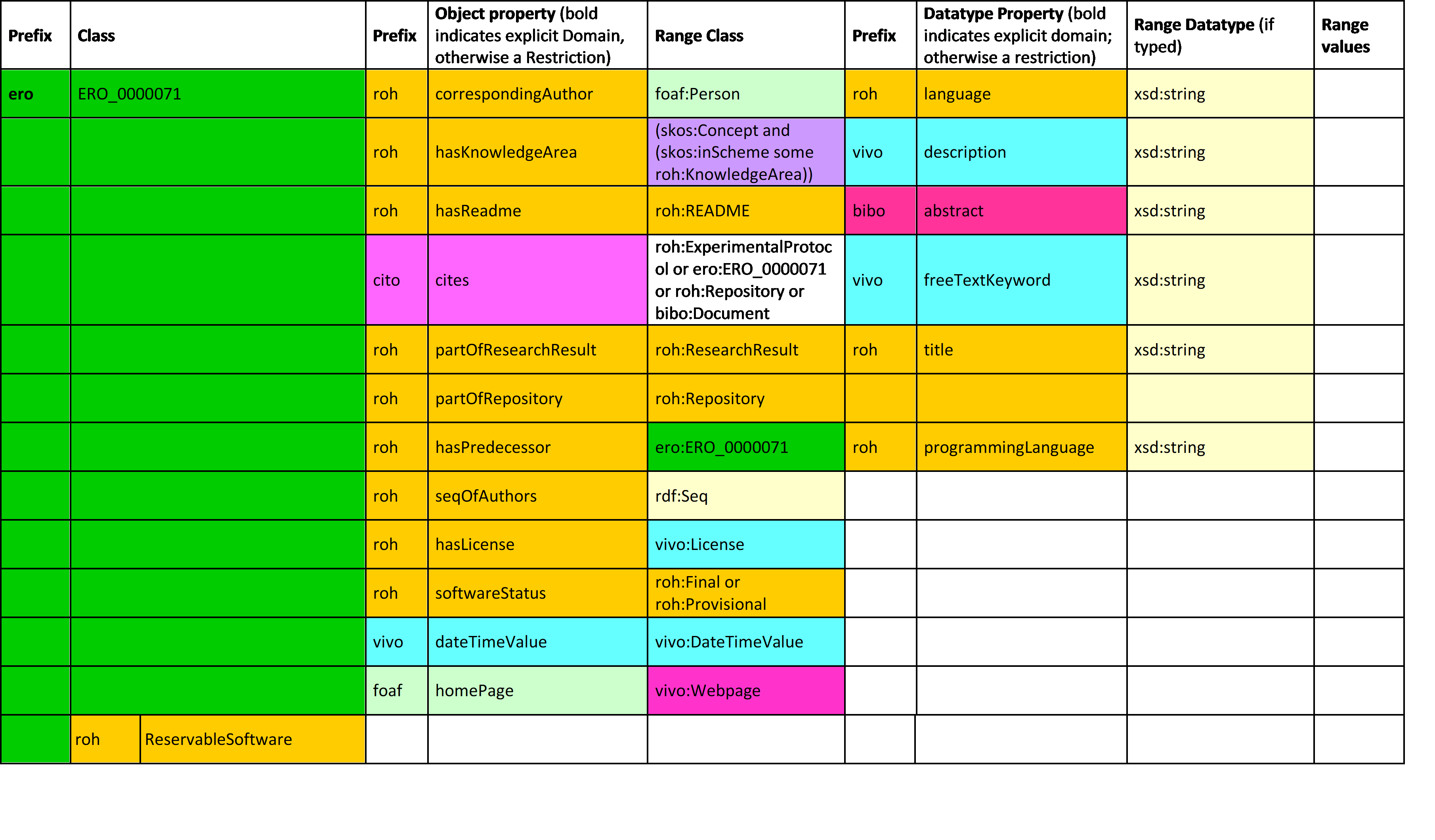
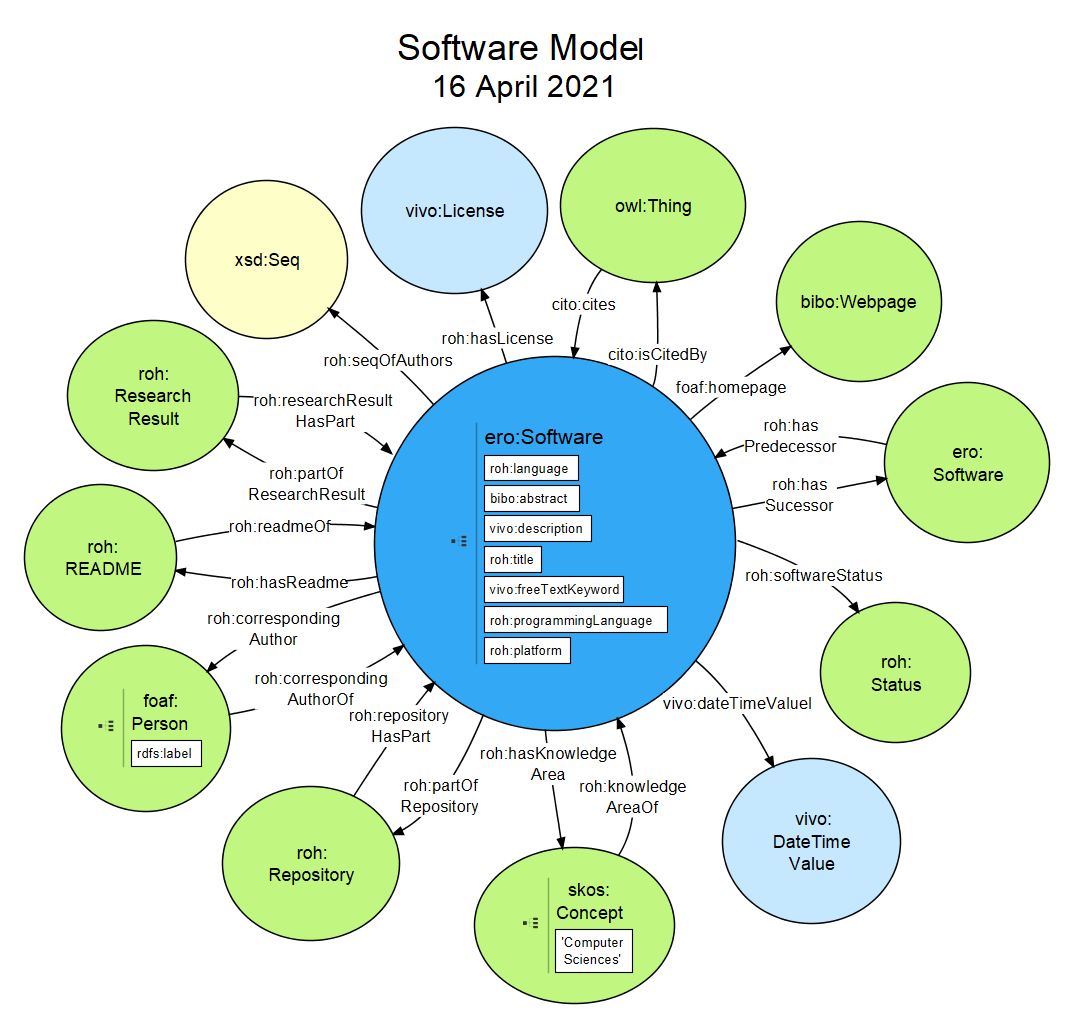
Figura 9. Ontological diagram for Software.
8. Activity entity
The entity research activity (roh:Activity), new in ROH and visualized in Figura 8, represents the activities in which People participate (roh:participes) and organized by Organizations (foaf:Organization) reflected through the roh:hasRole relationship that connects with the intermediary entity vivo:OrganizerRole. Each activity is usually linked to a project through the relationship (roh:participes) and causes a project expenditure linked through (vivo:relates). A detailed hierarchy of activity subtypes is defined below roh:Activity: bibo:Conference, vivo:Course, vivo:Internship or roh:ThesisViva.
Related to Activity, it is also important to describe roh:Expense, which denotes the expenses incurred either by a project (vivo:Project) or person (foaf:Person) and associated through relationship roh:spends. Every expense has a time instant of associated expense (vivo:DateTimeValue) and other properties that qualify it as (roh:monetaryAmount, roh:currency, roh:title or vivo:description. The following subclasses of roh:Expense have been defined: roh:PatentExpense, roh:PesonExpense, roh:ProjectExpense and roh:ResearchObjectExpense. Besides, each expense can have associated a different type of expense through roh:hasExpenseClassification (Congress/network, external recruitment, Investment/inventory, office, other costs, publication, representation or staff expenses).
The following table illustrates the class hierarchy, object and data properties defined by roh:Activity.


Figura 8. Ontological diagram for entity Activity.
9. Other entities in ROH
For more details on other entities in ROH check the tables detailing class hierarchies, object and data properties for all entities defined in ROH at the following PDF file: https://github.com/HerculesCRUE/ROH/blob/gh-pages/1-%20OntologyDocumentation.pdf.
Bibliography
[1] «Ontology Reference - VIVO 1.10.x Documentation - LYRASIS Wiki». [En línea]. Disponible en: https://wiki.lyrasis.org/display/VIVODOC110x/Ontology+Reference. [Accedido: 12-feb-2020].
[2] «Current research information system - Wikipedia». [En línea]. Disponible en: https://en.wikipedia.org/wiki/Current_research_information_system. [Accedido: 14-feb-2020].
[3] «CERIF 1.5 Reference». [En línea]. Disponible en: https://www.eurocris.org/Uploads/Web%20pages/CERIF-1.5/cerif.html#cfResProd. [Accedido: 13-feb-2020].
[4] «euroCRIS | Current Research Information Systems». [En línea]. Disponible en: https://www.eurocris.org/. [Accedido: 14-feb-2020].
[5] «SKOS Simple Knowledge Organization System Namespace Document 30 July 2008 “Last Call” Edition». [En línea]. Disponible en: https://www.w3.org/TR/2008/WD-skos-reference-20080829/skos.html. [Accedido: 13-feb-2020].
[6] «Public Procurement Ontology». [En línea]. Disponible en: http://contsem.unizar.es/def/sector-publico/pproc.html. [Accedido: 13-feb-2020].
[7] «CVN». [En línea]. Disponible en: https://cvn.fecyt.es/editor/cvn.html?locale=spa#ENTRADA. [Accedido: 13-feb-2020].
[8] «SWRC-FE (SWRC Funding Extension) | MORElab Ontologies». [En línea]. Disponible en: https://morelab.deusto.es/ontologies/swrcfe. [Accedido: 13-feb-2020].
[9] «GeoNames Ontology - Geo Semantic Web». [En línea]. Disponible en: http://www.geonames.org/ontology/documentation.html. [Accedido: 13-feb-2020].
[10] «FOAF Vocabulary Specification». [En línea]. Disponible en: http://xmlns.com/foaf/spec/. [Accedido: 12-feb-2020].
[11] «Bibliographic Ontology Specification | The Bibliographic Ontology». [En línea]. Disponible en: http://bibliontology.com/. [Accedido: 13-feb-2020].
[12] «OOPS! – OntOlogy Pitfall Scanner!» [En línea]. Disponible en: http://mayor2.dia.fi.upm.es/oeg-upm/index.php/en/technologies/292-oops/index.html. [Accedido: 13-feb-2020].